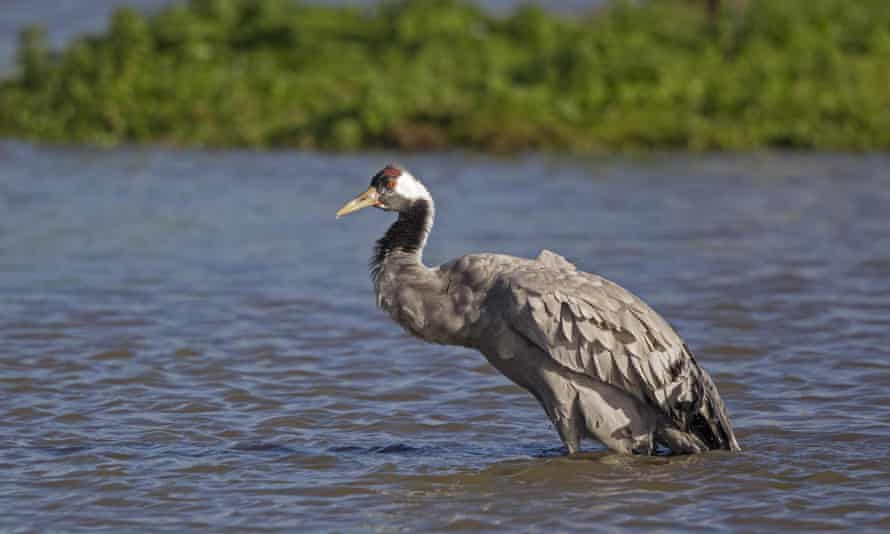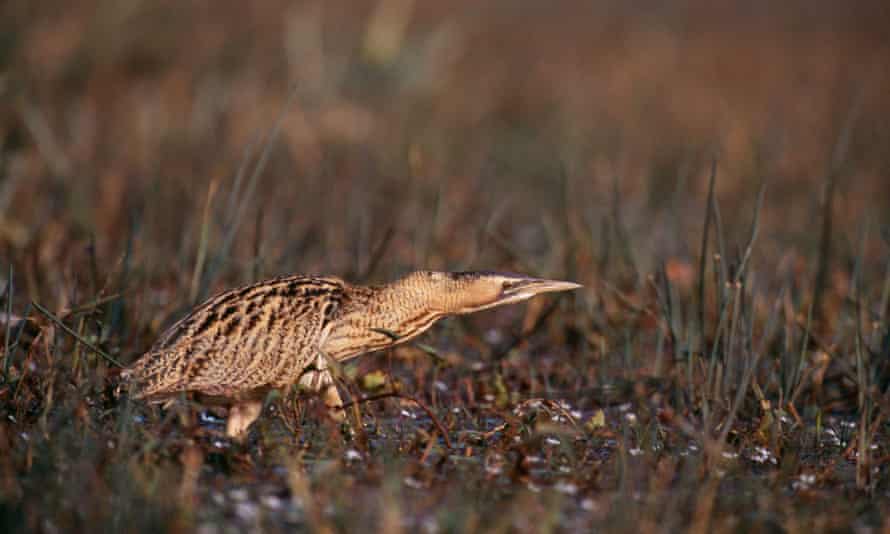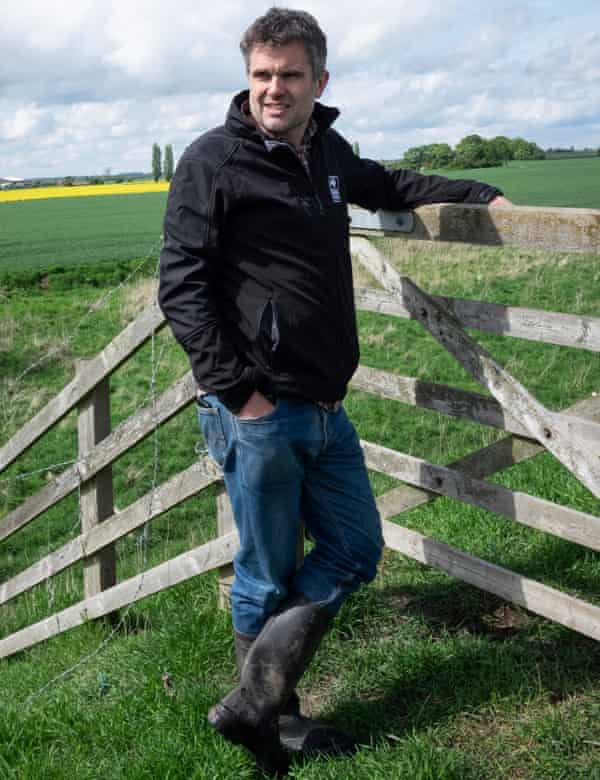[ad_1]
A small patch of Bourne North Fen in Lincolnshire offers an intriguing distinction to the huge stretches of wheat and rapeseed that encompass it. Untended for years, this little piece of land is now lined with grass and reeds surrounding a wooden of willow and alder.
Final week, between downpours, this tiny six-hectare plot bristled with wildlife: a cuckoo referred to as insistently; the occasional booming sound of the bittern – one among Britain’s rarest birds – might be heard; a hare ambled round.
It’s a tiny paradise, set in a few of England’s most intensely farmed landscapes. And if Lincolnshire Wildlife Belief has its method, there may be probably quickly to be a tenfold enhance on this exercise at Bourne North Fen.
The belief is now negotiating to take over 60 hectares of surrounding farmland, at the moment planted with subject beans, and return it to pure fen. Reed beds can be restored, river water can be cleaned and growing quantities of carbon can be captured by flourishing plant life.
For good measure, extra uncommon species are prone to return – following the instance of close by Willow Tree Fen reserve, the place cranes have begun breeding for the primary time in 400 years in Lincolnshire.

It’s an encouraging image, though the Bourne North Fen rewilding can have solely a modest affect by itself. Sixty hectares is a minuscule space in contrast with an area panorama that has been reworked by farming through the years and has allowed Lincolnshire to provide greater than 20% of all foodstuffs grown within the UK. Alternatively, the undertaking offers a key illustration of the motion now desperately wanted to protect nature within the UK, says Craig Bennett, chief govt of the Wildlife Trusts.
“Over the past yr, we’ve been reminded – fairly rightly – that we have to shield the well being service,” Bennett mentioned throughout his go to final week to Bourne North Fen. “However contemplate the pressure placed on the well being service by placing nature into decline. First there may be the affect on the nation’s mental health after which there may be the hurt completed to our bodily wellbeing.”
An instance of the latter drawback is offered by air pollution, added Bennett. “With inadequate timber in cities, poisoned air has constructed up alarmingly, and that has price the well being service big quantities of cash coping with the ensuing instances of respiratory illness. We’re a part of nature, not separate from it, and we have to begin behaving like that’s the case.”
The Observer’s interview with Bennett was organized to mark his first anniversary answerable for the Wildlife Trusts, having left Mates of the Earth – the place he was additionally chief govt – final yr.
For the previous 12 months, he has led the actions of 46 native wildlife trusts that make up his organisation and who run greater than 2,400 reserves masking virtually 100,000 hectares within the UK. “Collectively, we’ve obtained extra nature reserves than McDonald’s has obtained eating places on this nation,” Bennett boasts.
It’s nonetheless a reasonably modest quantity of land. Nonetheless, by slowly shopping for up land and connecting reserves it’s hoped, sooner or later, to assist create sufficient refuges and so assist halt the devastation of UK wildlife that has been brought on by a quadruple whammy of urbanisation, agriculture, air pollution and the local weather disaster over the previous century.
Consequently, a whole bunch of species are actually prone to disappearing from our shores. For instance, numbers of hedgehogs have declined by 95% because the Fifties, turtle doves have crashed by 98% and even numbers of the frequent toad have fallen by 68%. Bennett’s goal, by means of the Wildlife Trusts, is to halt these alarming declines in order that the graphs exhibiting dwindling species numbers and diminishing habitats begin to level upwards for the primary time in centuries.

These are laudable aspirations, although they’ve lacked particular targets, Bennett admits. “Take into account local weather change. There you will have a really particular objective – to restrict warming to 1.5 or 2 levels.”
One thing related was wanted for the conservation motion, which has not too long ago give you a brand new focused strategy to tackling our wildlife disaster by means of the 30 by 30 campaign. “Fairly merely, we are actually calling for a minimum of 30% of our land and sea to be linked and guarded for nature’s restoration by 2030. That could be a very particular aspiration.”
At current, solely round 10% of UK land can be thought-about as protected for pure restoration, says Bennett though he provides that half of these websites are in fairly poor situation.
An unlimited quantity nonetheless must be completed, but this view is just not shared by the UK authorities. It not too long ago argued – in response to urging from the 30 by 30 motion – that round 26% of British land was “in a pure state”.
The declare is dismissed out of hand by Bennett. “A lot of the land they’re speaking about is in nationwide parks and far of it’s managed as areas of excellent magnificence or as landscaped grounds. They aren’t pure in any respect. So we must be clear: we’re very removed from being only some proportion factors in need of our 30 by 30 objective.”

Neither is habitat loss the one subject concerned in saving British wildlife, Bennett provides. “The huge, widespread and routine use of pesticides, that are getting used an increasing number of incessantly and in doses of elevated toxicity, has had a devastating impact.
“When you drove at evening in summer time you used to must clear your headlights of useless bugs. Now there are so few that you just don’t must hassle.”
An instance of the hazard is offered by neonicotinoid pesticides now linked to bee population declines. “In truth, one teaspoon of neonicotinoid can kill 1 / 4 of a billion bees. It’s to bees what novichok is to people. How did we ever get to a stage the place we thought it was a good suggestion to be utilizing such chemical substances? It’s unbelievable. We’d like an actual change in mindset.”
Then there may be the difficulty of water. Its home use has elevated by 70% because the Nineteen Eighties to fulfill rising numbers of dishwashers and washing machines, to provide greenhouses the place out-of-season meals is now grown, and to fulfill the wants of the leisure business and golf programs.
The huge demand for water has triggered our wetlands and rivers to dry up. “Only a few of our rivers even have the amount of water they must be correctly functioning ecosystems. We badly want to scale back the quantities of water we’re taking from rivers and streams and let our wetlands get moist once more.”
Tackling these points is a large, formidable enterprise however, until one thing occurs, we face an uncomfortable future.
For the reason that 1500s, round 130 species have turn into extinct within the UK – from the lynx and wolf to the apple bumblebee, Mitten’s beardless moss and the frequent tree frog. This determine will likely be dwarfed by the hundreds of extinctions we now face until we begin restoring nature to the UK.
Bennett stays optimistic. “Locations like Bourne North Fen might play solely a small half in that restoration but when it succeeds, as I imagine it is going to, it is going to sign that there’s some likelihood that we will get out of the mess during which we discover ourselves.”
[ad_2]
Source link


